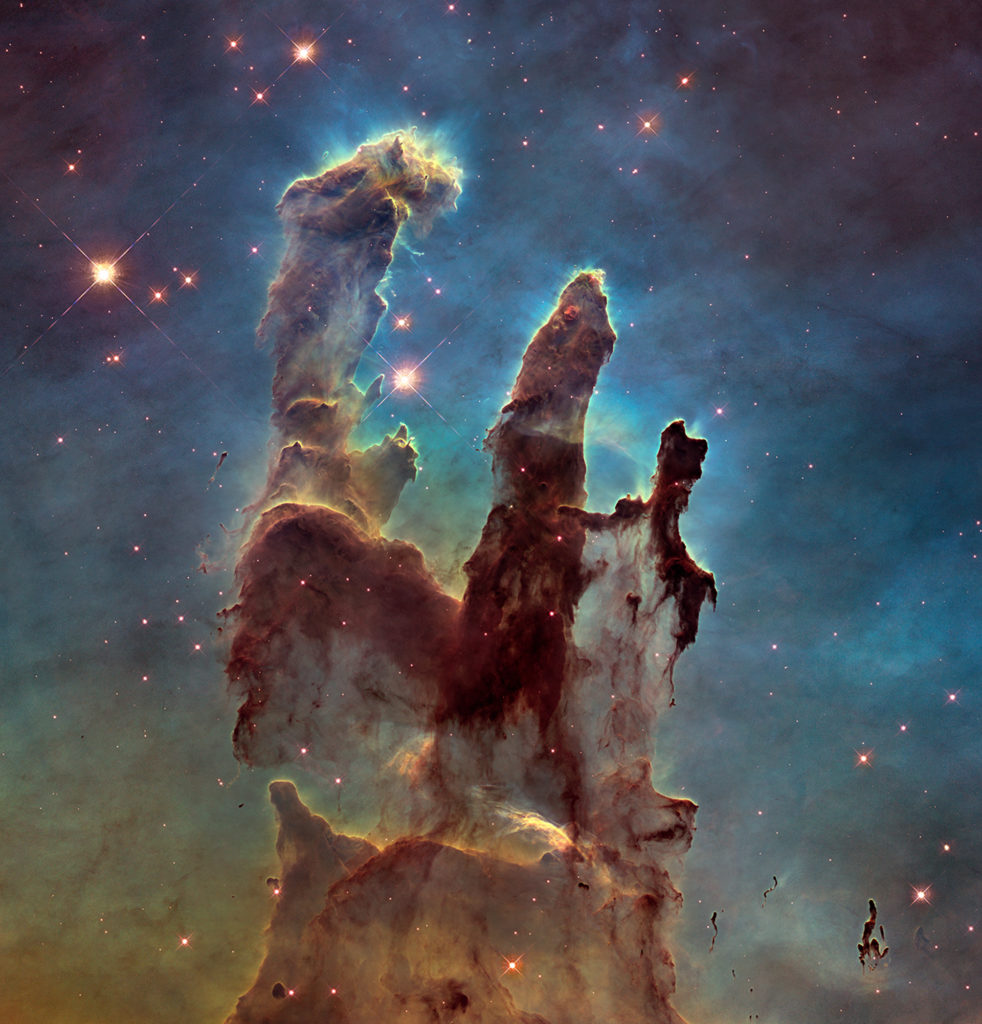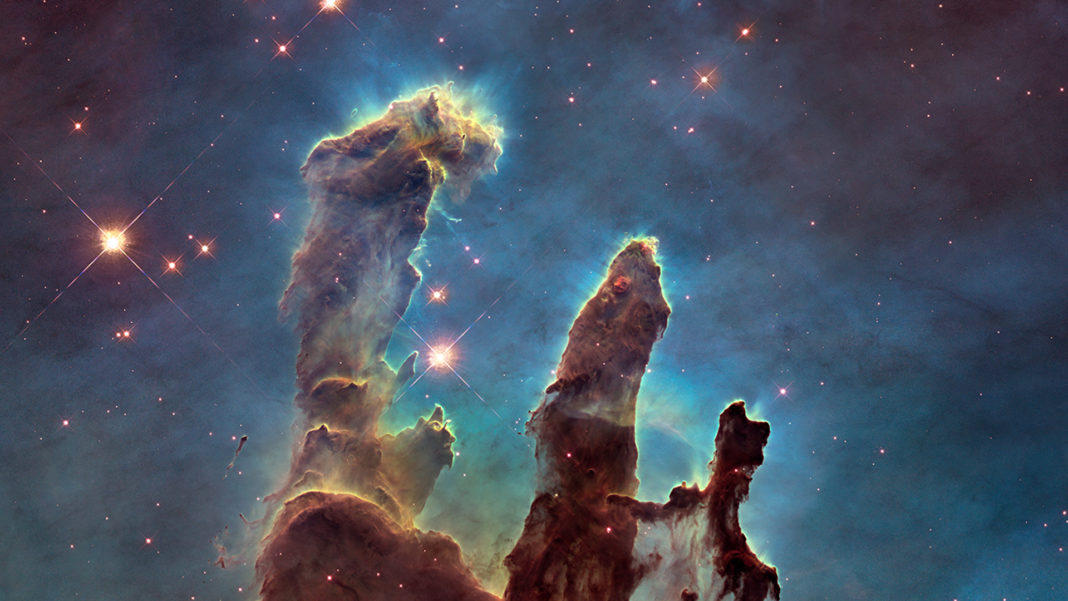Twinkle, twinkle, little star, sings every small child. Why have the diamonds in the sky never come wondering what we are?
“What is the stars, Joxer, what is the stars?” asked Sean O’Casey, 96 years ago, in Juno and the Paycock, but then every human being, since first we came down from the trees, has looked to the stars and wondered what they are, and what our place is among them.
We travelled out from East Africa, guided by the golden light of the sun, the silver of the moon, and the infinite, twinkling diamonds of the stars. We sat around the fire and told ourselves stories in the cold and the dark, stories which not only changed the way we looked at the world, but which changed us too, each yarn laying pathways in our primitive brains, each punchline firing up neurons, each narrative twist opening up synapses, the lights in the sky matched only by the lights in our minds.
Upon the vast canvas above us we wrote our mythologies and painted our epic sagas, gods and demons wrestling for supremacy, heroes and villains fighting never-ending battles, the saints and archetypal angels sparking our imaginations even as our ideas expanded the architecture of our own brains.
Stories made us who we are, and what we are. Stories told our world what it is and stories told our people who they could be. Stories built our villages, our skyscrapers, our atrocities and our space stations.
And every step of the way, humanity’s story has been lit by the heavens. We’ve always looked to the stars and wondered what they are, and never once, so far as we know, have the heavens looked back and wondered what we are.
As Bruce Springsteen likes asking his audiences, “Is there anybody ALIVE out there?!”
We have always been fascinated by the notion of alien life. According to astrobiologist Caleb A Scharf, writing in the Scientific American, one of the first known pieces of writing about aliens dates to 200AD, and was the work of Lucian of Samosato, a satirist in Eastern Turkey.
Lucian’s Vera Historia (True Story) tells of a trip to the Moon, and an encounter with the various lunar lifeforms, including three-headed vultures, humans who sweat milk, and elephant-sized fleas. The people of the Moon were at war with the people of the Sun, over the vexed question of colonisation of the Morning Star. Lucian wasn’t really saying this was a true story, but rather he was making the philosophical point that real truth is impossible, and having a go at other writers – the great Plato included – presenting themselves as the arbiters of truth.

Scharf notes that the moon has always been our first imaginative port of call for alien life, with the 10th century Japanese narrative, The Tale of Princess Kaguya, features a lunar princess sent to Earth. He also points out that it was not until 1859, when, to quote R.E.M., Mister Charles Darwin had the gall to ask, that we really began to imagine aliens as creatures subject to their own environments and evolution.
Scharf instances the works of the 19th century French astronomer and author Camille Flammarion, who posited aliens that had some basis in then-current scientific thinking, sentient plants, mer-creatures swimming in rose-coloured seas, and mutated humans with extra toes, or conical ears atop their heads.
Flammarion’s contemporaries, Jules Verne and H.G. Welles, are often credited as the fathers of science fiction. Two decades after Verne sent men From the Earth to the Moon, Welles’ Martians invaded in 1897’s The War of the Worlds, Their stories thrilled audiences and opened minds, and soon Edgar Rice Burroughs took us to the Mars of his imagination, Barsoom. Our fascination with aliens increased exponentially through the 20th century, and otherworldly characters became an increasingly prominent part of popular culture, from the villains attacking Flash Gordon, Buck Rogers, and Dan Dare, to alien heroes like Superman, Spock, and ET, from the writings of Asimov, and Clarke, and Bradbury, to television programmes like Star Trek and Battlestar Galactica and Doctor Who, to the films of Kubrick and Spielberg and Lucas.
We have searched the skies for over a century for signs of alien intelligence, since Nikola Tesla thought, in 1899, that he had detected a signal from Mars, and up through astronomer Frank Drake’s 1960 Project Ozma, to the modern SETI (Search for Extra-Terrestrial Intelligence). But – despite several false alarms – we have never found proof of life.
We live on a planet where life began maybe 4.5 billion years ago, in a galaxy 100,000 light years across and 10 billion years old. We estimate our Milky Way galaxy contains 300 billion stars, with perhaps 10 billion temperate planets capable of supporting life.
“But,” as Italian physicist Enrico Fermi asked in 1950, “where are all the aliens?”
In a superb piece in the January edition of Scientific American, Caleb A Scharf offers possible explanations for why we seem so all alone in the universe. Scharf suggests that Earth may be an out-of-the-way planet in a remote area of the galaxy, perhaps at a time of a lull in the activities of spacefaring civilisations.
Or perhaps Earth was visited in the past, and perhaps all signs of those visits have been washed away by the passage of time. (They should have invested in monoliths.)
Perhaps the vast distances of space are too great for sentient life to survive the trip. Scharf notes that even attaining 10% of light speed would necessitate technology like fusion bombs and laser-driver light sails, technology currently far beyond us.
Who knows? Perhaps alien life is so far beyond us, so far above us, as to be unknowable, as to be unreachable, as to be akin to God. Perhaps the aliens are utterly uninterested in us.
Perhaps.
I have my own theory.
In Star Trek, there’s something called “The Prime Directive”, a stricture whereby it is forbidden to interfere in the development of civilisations which have yet to achieve faster-than-light space travel. The excellent 1996 Star Trek: First Contact (the one with the cyber-zombie Borg) revolves around an extra-temporal alien aggressor attempting to prevent humanity from reaching warp speed, and thus prevent our being accepted into the greater galactic community.
Perhaps there’s a real-life Star Trek reason we haven’t been contacted. Perhaps the advanced races of the galaxy apply to primitive cultures a similar threshold of development below which planets remain in quarantine.
After all, for as long as we’ve been scanning the skies for signs of intelligent life, we’ve also been broadcasting radio signals, telling the universe of our wars, our atrocities, our pogroms and our desecration of our planet. In 1977, we sent the Voyager probes out into the endless night, carrying goodwill to all, and Bach, and Mozart, and Stravinsky, and Beethoven, and Blind Willie Johnson, and Chuck Berry.
By that point, though, news of Auschwitz, and Hiroshima and Nagasaki, and our famines, old and new, and Biafra, and Turkey, and My Lai, and the USSR, and all our other sins, already had an unbeatable head-start.
Given humanity’s inhumanity, who could blame the aliens for self-isolating?








